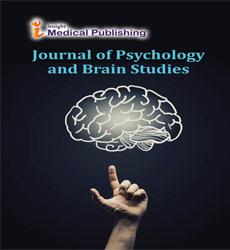Neurostimulation's Antidepressant Therapeutic Efficacy
Sushree Sunena*
Department of Psychology, Utkal University, Bhubaneswar, Odisha, India
- *Corresponding Author:
- Sushree Sunena
Department of Psychology
Utkal University
Bhubaneswar, Odisha, India
E mail: sushreesunena04@gmail.com
Received Date: September 07, 2021; Accepted Date: September 12, 2021; Published Date: September 17, 2021
Citation: Sunena S (2021) Neurostimulation’s Antidepressant Therapeutic Efficacy. J Psychol Brain Stud Vol. 5 No.9:42.
Perspective
Neurostimulation is the intentional modification of nervous system activity through the use of invasive (e.g. microelectrodes) or non-invasive methods (e.g. transcranial magnetic stimulation or transcranial electric stimulation, tES, such as tDCS or transcranial alternating current stimulation, tACS. Electromagnetic techniques to neuromodulation are commonly referred to as neurostimulation. Neurostimulation technology can help those who are severely paralysed or have substantial losses to multiple sense organs, as well as those who suffer from severe, chronic pain that would otherwise necessitate constant (round-the- clock) high-dose opioid medication (such as neuropathic pain and spinal-cord injury). It's used in hearing aids, artificial vision, artificial limbs, and brain-machine interfaces, among other things. Some illnesses, such as epilepsy, may benefit from brain stimulation.
Scheduled stimulation is administered to specific cortical or subcortical targets in this procedure. Commercially available devices can deliver an electrical pulse at predetermined intervals. The intrinsic neurophysiologic features of epileptic networks are thought to be altered by scheduled stimulation. The anterior nucleus of the thalamus and the hippocampus has been the most studied targets for planned stimulation. Several months after stimulator implantation, the anterior nucleus of the thalamus was investigated, and it was shown that with the stimulator on vs. off, there was a considerable reduction in seizure frequency. There is no proven treatment for depression. Treatment-resistant depression affects one-third of depressed people, who do not respond to typical treatment methods such as antidepressants, psychotherapy, or cognitive therapies. Around 40% of people who respond to antidepressant medication have persistent symptoms later in life, whereas 30% do not respond to treatment at all.
Electroconvulsive Therapy (ECT) is a type of electroconvulsive technique for treating depression symptoms. When medication and psychotherapy have failed to alleviate severe depression, this treatment is done as a last resort. To prevent movement during the operation, patients are given general anaesthesia and a muscle relaxant before ECT. Throughout the procedure, the patient's blood pressure, respiration, and heart rate are all monitored. ECT has been demonstrated to be more effective than antidepressant medications in large-scale clinical investigations of depression. ECT is a valid therapy for the treatment of depression, particularly severe and resistant types, according to a few studies. Since the 1960s, researchers have been studying the effects of transcranial direct current stimulation (tDCS) on mood and the treatment of depression in people. A low-intensity direct current is delivered to cortical areas with tDCS. The stimulations last a few minutes and modify neuronal excitability in the targeted areas of the brain. Recent clinical trials have indicated a current strength of 1–2 mA, delivered for 10–20 minutes per session via sponge-based rectangular pads. The transcranial direct current stimulation (tDCS) approach has been utilised to investigate the functions of cortical areas as well as to treat depression.
40 patients with significant depression were randomly assigned to one of three treatment groups: anodal tDCS of the left DLPFC (the active group), anodal tDCS of the occipital cortex (the active control group), or sham tDCS (the placebo control group). Anodal stimulation was administered over the left DLPFC and the cathode was placed on the lateral portion of the contralateral orbit in another double-blind randomised trial on 40 depressive patients. The Montgomery–sberg scale was used to assess mood outcomes after each patient had tDCS for ten consecutive sessions.
TMS (Transcranial Magnetic Stimulation) is a type of repetitive transcranial magnetic stimulation that was first introduced in 1985. It's a non-invasive cerebral cortex neurophysiological stimulation approach. Magnetic pulses are sent to the cortex during the operation. The magnetic pulses cause an electrical current to flow through the brain tissue, depolarizing the target neurons. The electrode placement and stimulation intensity are crucial to performing effective rTMS, as they affect whether or not the patient will react to therapy.
Open studies have shown that Vagus Nerve Stimulation (VNS) modifies the concentrations of neurotransmitters or their metabolites, as well as the functional activity of CNS areas, in depression and other mood-related illnesses. The concentrations of monoamines in the CNS are altered by VNS treatment. It affects the levels of the neurotransmitters serotonin, norepinephrine, GABA, and glutamate, all of which are linked to depression.
According to preliminary research, ECT is even more effective than rTMS. Despite its higher efficacy, ECT's use is restricted due to the negative cognitive effects and the need of anaesthesia. A few adjustments were made to acquire more control over seizure induction in order to decrease these limitations. As an alternative, Magnetic Seizure Treatment (MST) has been created. ECT and MST both cause seizures, but MST is more focused, has a higher antidepressant efficacy, and is easier to tolerate. Although seizure therapy is highly successful in TRD, adverse effects such as recurrent memory loss and cognitive consequences have limited the use of ECT/MST as a long-term treatment option for most patients. FDA-approved VNS can be utilised for long-term treatment. Non-invasive stimulation approaches have been the focus of neuroscientists. tDCS is excellent at reducing symptoms while having little adverse effects like redness, irritation, and headache.
Open Access Journals
- Aquaculture & Veterinary Science
- Chemistry & Chemical Sciences
- Clinical Sciences
- Engineering
- General Science
- Genetics & Molecular Biology
- Health Care & Nursing
- Immunology & Microbiology
- Materials Science
- Mathematics & Physics
- Medical Sciences
- Neurology & Psychiatry
- Oncology & Cancer Science
- Pharmaceutical Sciences
